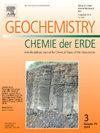北祁连地块大恰达班蛇绿岩中寒武系洋中脊玄武岩基性岩及其伴生博长岩:成因及其弧后伸展意义
IF 2.9
3区 地球科学
Q2 GEOCHEMISTRY & GEOPHYSICS
引用次数: 0
摘要
早古生代祁连造山带是研究古板块构造过程的理想区域,可分为祁连北段、祁连中段和祁连南段。一致认为北祁连洋岩石圈是在阿拉善地块下向北俯冲的。然而,对于北祁连海俯冲的细节(如是否发育洋内弧后盆地)却知之甚少。本文对北祁连地块大恰达班蛇绿岩中寒武系(513 ~ 506 Ma)下系类海中脊玄武岩(MORB)基性岩和上系(503 ~ 490 Ma)博长岩进行了岩石学观测、锆石UPb年代学和Hf同位素分析、全岩和矿物主微量元素及SrNd同位素分析。下系基性岩可进一步分为两类。1型基性岩SiO2含量均匀,为45.1 ~ 49.8 wt%,轻稀土元素(REE)略富集,重稀土元素模式相对平坦,与富集型morb相似。2型基性岩和博长质岩的SiO2含量范围较宽,分别为49.3 ~ 59.2%和48.1 ~ 56.6%,贫轻稀土,重稀土模式相对平坦,与正常型morb相似。在原始地幔归一化元素图中,1型和2型基性岩没有或可以忽略NbTa的损耗,而boninite则表现出明显的NbTa损耗。下系1型和2型基性岩贫全岩Nd (εNd[t] = +2.6 ~ +6.5)和锆石Hf (εHf[t] = +2.8 ~ +14.8)同位素组成,上系博宁质岩贫NdHf (εNd[t] = +2.8 ~ +4.7);εHf[t] = +3.4 ~ +13.6)同位素组成。认为下统1型和2型基性岩是由深70 km的石榴石辉橄榄岩部分熔融形成的;1型)和尖晶石尖刺石(70 km;类型2)地幔源。上部系列的博宁质来源于一个由俯冲沉积物衍生的熔体和少量板块衍生流体交代作用的难熔硬质地幔源。结合区域地质资料,认为北祁连洋经历了前寒武纪—早寒武世(550 ~ 520 Ma)、中晚寒武世(513 ~ 497 Ma)和中晚奥陶世(458 ~ 449 Ma)三个扩张阶段。此外,在中晚寒武世(513-490 Ma),北祁连海下发生了洋内俯冲和弧后伸展。本文章由计算机程序翻译,如有差异,请以英文原文为准。

Cambrian mid-ocean ridge basalt-like mafic rocks and associated boninites in the Dachadaban ophiolite from the North Qilian Block, northwest China: Petrogenesis and implications for back-arc extension
The early Paleozoic Qilian Orogen is ideal for investigating ancient plate tectonic processes and can be divided into the north, middle, and south Qilian blocks. There is a consensus that North Qilian oceanic lithosphere was subducted northward beneath the Alxa Block. However, the details of this subduction in the North Qilian Ocean (e.g., whether an intra-oceanic back-arc basin was developed) are poorly constrained. In this study, we undertook petrological observations, zircon U![]() Pb geochronological and Hf isotopic analyses, and whole–rock and mineral major and trace element, and Sr
Pb geochronological and Hf isotopic analyses, and whole–rock and mineral major and trace element, and Sr![]() Nd isotopic analyses of the Cambrian (513–506 Ma) lower series mid-ocean ridge basalt (MORB)-like mafic rocks and upper series (503–490 Ma) boninites in the Dachadaban ophiolite in the North Qilian Block, northwest China. The lower series mafic rocks can be further divided into two types. Type 1 mafic rocks have uniform SiO2 contents of 45.1–49.8 wt% and slightly enriched light rare earth element (REE) and relatively flat heavy REE patterns, similar to enriched-type MORBs. The type 2 mafic rocks and boninites have a wider range of SiO2 contents of 49.3–59.2 and 48.1–56.6 wt%, respectively, and are depleted in light REEs and have relatively flat heavy REE patterns, similar to normal-type MORBs. In primitive-mantle-normalized element diagrams, the type 1 and 2 mafic rocks exhibit no or negligible Nb
Nd isotopic analyses of the Cambrian (513–506 Ma) lower series mid-ocean ridge basalt (MORB)-like mafic rocks and upper series (503–490 Ma) boninites in the Dachadaban ophiolite in the North Qilian Block, northwest China. The lower series mafic rocks can be further divided into two types. Type 1 mafic rocks have uniform SiO2 contents of 45.1–49.8 wt% and slightly enriched light rare earth element (REE) and relatively flat heavy REE patterns, similar to enriched-type MORBs. The type 2 mafic rocks and boninites have a wider range of SiO2 contents of 49.3–59.2 and 48.1–56.6 wt%, respectively, and are depleted in light REEs and have relatively flat heavy REE patterns, similar to normal-type MORBs. In primitive-mantle-normalized element diagrams, the type 1 and 2 mafic rocks exhibit no or negligible Nb![]() Ta depletion, while the boninites exhibit obvious Nb
Ta depletion, while the boninites exhibit obvious Nb![]() Ta depletion. The lower series type 1 and 2 mafic rocks have depleted whole-rock Nd (εNd[t] = +2.6 to +6.5) and zircon Hf (εHf[t] = +2.8 to +14.8) isotopic compositions, while the upper series boninites have relatively enriched Nd
Ta depletion. The lower series type 1 and 2 mafic rocks have depleted whole-rock Nd (εNd[t] = +2.6 to +6.5) and zircon Hf (εHf[t] = +2.8 to +14.8) isotopic compositions, while the upper series boninites have relatively enriched Nd![]() Hf (εNd[t] = +2.8 to +4.7; εHf[t] = +3.4 to +13.6) isotopic compositions. We suggest that the lower series type 1 and 2 mafic rocks were formed by partial melting of garnet lherzolite (>70 km depth; type 1) and spinel harzburgite (<70 km; type 2) mantle sources, respectively. The upper series boninites were derived from a refractory harzburgitic mantle source that had been metasomatized by subducted-sediment-derived melts and minor slab-derived fluids. Based on these results and regional geological data, we suggest that the North Qilian Ocean experienced three stages of expansion, in the Precambrian–early Cambrian (550–520 Ma), middle–late Cambrian (513–497 Ma), and Middle–Late Ordovician (458–449 Ma). In addition, intra-oceanic subduction beneath the North Qilian Ocean and subsequent back-arc extension occurred during the middle–late Cambrian (513–490 Ma).
Hf (εNd[t] = +2.8 to +4.7; εHf[t] = +3.4 to +13.6) isotopic compositions. We suggest that the lower series type 1 and 2 mafic rocks were formed by partial melting of garnet lherzolite (>70 km depth; type 1) and spinel harzburgite (<70 km; type 2) mantle sources, respectively. The upper series boninites were derived from a refractory harzburgitic mantle source that had been metasomatized by subducted-sediment-derived melts and minor slab-derived fluids. Based on these results and regional geological data, we suggest that the North Qilian Ocean experienced three stages of expansion, in the Precambrian–early Cambrian (550–520 Ma), middle–late Cambrian (513–497 Ma), and Middle–Late Ordovician (458–449 Ma). In addition, intra-oceanic subduction beneath the North Qilian Ocean and subsequent back-arc extension occurred during the middle–late Cambrian (513–490 Ma).
求助全文
通过发布文献求助,成功后即可免费获取论文全文。
去求助
来源期刊

Chemie Der Erde-Geochemistry
地学-地球化学与地球物理
CiteScore
7.10
自引率
0.00%
发文量
40
审稿时长
3.0 months
期刊介绍:
GEOCHEMISTRY was founded as Chemie der Erde 1914 in Jena, and, hence, is one of the oldest journals for geochemistry-related topics.
GEOCHEMISTRY (formerly Chemie der Erde / Geochemistry) publishes original research papers, short communications, reviews of selected topics, and high-class invited review articles addressed at broad geosciences audience. Publications dealing with interdisciplinary questions are particularly welcome. Young scientists are especially encouraged to submit their work. Contributions will be published exclusively in English. The journal, through very personalized consultation and its worldwide distribution, offers entry into the world of international scientific communication, and promotes interdisciplinary discussion on chemical problems in a broad spectrum of geosciences.
The following topics are covered by the expertise of the members of the editorial board (see below):
-cosmochemistry, meteoritics-
igneous, metamorphic, and sedimentary petrology-
volcanology-
low & high temperature geochemistry-
experimental - theoretical - field related studies-
mineralogy - crystallography-
environmental geosciences-
archaeometry
 求助内容:
求助内容: 应助结果提醒方式:
应助结果提醒方式:


